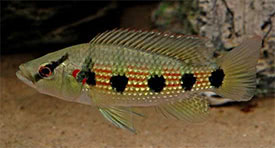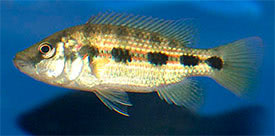
 Magyarul / Hungarian
Magyarul / Hungarian



- Scientific name: Hemichromis elongatus
- Synonyms: Chromichthys elongatus, Hemichromis auritus
- Common name: Banded jewel cichlid, Five Star General
- Group: Cichlids
- Habitat: Africa; Guinea, Cameroon, Angola, Namibia, Botswana and Zimbabwe.
- Size: 15-18 cm
- Biotope: Inhabits in rivers and lakes, and in Africa’s western coast area the fish even enter brackish waters.
- Social behavior: Highly aggressive and predatory fish. They should be kept in a species tank in pairs.
- Diet: Carnivorous; It feeds mainly on fish in the nature, but in the aquarium it will accept other meaty live and frozen foods, such as earthworms and mussel. Dried foods are usually accepted.
- Breeding: Quite easy
- Tank: Minimum 110 litres
- Population: 1 pair for 110 litres.
- Decoration: Needs a tank with dense vegetation and cave-like hiding places among rocks and roots. The fish tends to dig, so any plants will need to be very strongly rooted or potted.
- Temperature: 22-25 °C
- pH: 6.5-7.5
- Hardness: 5-15 NK°
- Lifespan: 5-8 years
Description: Hemichromis elongatus get its common name from the row of 5 dark markings that run laterally along the flanks of the fish. Five Star General has a longer, more predatory snout than other Hemichromis. Its base color is grey with five distinctive black spots along the length of the body: the first on the gill cover and the last on the caudal peduncle. These spots are surrounded by small iridescent bronze scales and in sexually active fish the spot on the gill cover is surrounded by a red coloration. The fins are smoky in color. Because of the patchy nature of its distribution, it might be that Hemichromis elongatus has either been misidentified at some of these locations, or is likely to be present in several additional countries. Banded jewel cichlid is rare in the hobby, because of its very aggressive behaviour, and in addition it is an efficient predator that, in some of its native countries, it is used to control populations of Tilapia. So Hemichromis elongatus is definitely not recommended for beginners.
A group of 5-6 young fish should be purchased and a pair allowed to form from those. However, even this may take some time. It is difficult to pair up adult Jewel Cichlids. Once a pair is seen to form, the other fish should be removed as they may be killed. The pair will remain together for life.
Males are a little larger, and more colourful than females, and develop extended dorsal and anal fins as they become older. It’s a substrate spawning species that forms monogamous pair bonds, so put some flat rock, or flowerpots into their aquarium that they can use as a spawning site. During the spawning season the fish will intensify in color, and they become even more aggressive, they will even attack the fingers of the fish keeper who will dare to put its hand in the tank. They will choose a spawning site on a flat rock, or the side of a flowerpot and clean it thoroughly. The male is very vigorously pursuit the female and she may be harassed to death if she is not ready to spawn. Before the spawning the fish usually rearrange the whole aquarium, often uproot the plants. As much as 800 eggs can be released by one female. The eggs hatch in around 48 hours, and the parents move the fry into shallow pits, what the parents previously dig in the substrate around the spawning site. The fry become free-swimming after 6 days, and they develop quickly. Brood care by the parents usually continues for about a month, after which the fry should be removed as the parents may spawn again.

















































